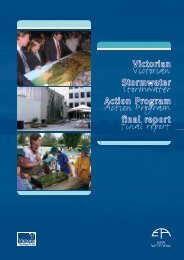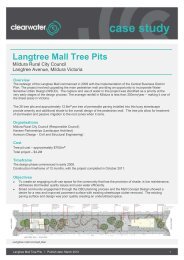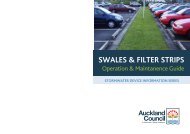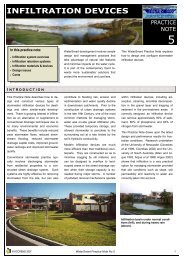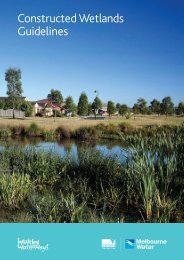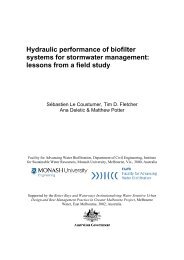CRC Street Sweep Eval 1999.pdf( 489.9 KB ) - Clearwater
CRC Street Sweep Eval 1999.pdf( 489.9 KB ) - Clearwater
CRC Street Sweep Eval 1999.pdf( 489.9 KB ) - Clearwater
You also want an ePaper? Increase the reach of your titles
YUMPU automatically turns print PDFs into web optimized ePapers that Google loves.
COOPERATIVE RESEARCH CENTRE FOR CATCHMENT HYDROLOGY<br />
10 Conclusions<br />
This study has investigated the effectiveness of street<br />
sweeping for stormwater quality improvement. A<br />
number of factors are identified as influencing the<br />
effectiveness of street sweeping for the collection of<br />
street surface pollutants for stormwater pollution<br />
control rather than just aesthetic requirements. These<br />
factors include street sweeping mechanism, pollutant<br />
type, sweeping frequency and timing and also<br />
pollutant wash-off characteristics.<br />
The most important conclusion from this study is that<br />
current Australian street sweeping practices are<br />
generally ineffective as an at source stormwater<br />
pollution control measure. Current street sweeping<br />
practices are found to be not only ineffective for the<br />
reduction of fine sediment and sediment-bound<br />
contaminants but also for larger gross pollutants<br />
capable of entering the stormwater system. Current<br />
Australian street sweeping mechanisms and practices<br />
are therefore regarded as providing very little benefit<br />
for stormwater quality improvements, due to<br />
inefficiencies at reducing a variety of pollutants from<br />
entering the stormwater system over a range of<br />
conditions. <strong>Street</strong> sweeping should be therefore<br />
accompanied by structural pollutant treatment<br />
measures to effectively reduce the discharge of gross<br />
and sediment associated pollutants in stormwater.<br />
Increasing the frequency of current street sweeping<br />
practices beyond what is required to meet aesthetic<br />
objectives is not expected to yield substantial<br />
incremental benefits in relation to receiving water<br />
quality improvements. There seems little benefit in<br />
conducting detailed field monitoring investigations<br />
into quantifying the effectiveness of street sweeping<br />
as a stormwater pollution control measure for current<br />
Australian street sweeping mechanisms or operations.<br />
Other specific observations from this study are listed<br />
below.<br />
<strong>Sweep</strong>ing Mechanisms<br />
Mechanical and regenerative air street sweeping<br />
equipment requires a minium threshold load of<br />
sediment on the street surface before they become<br />
effective.<br />
The threshold load can be three times higher for<br />
the mechanical sweeper compared to the<br />
regenerative air system.<br />
Overall the regenerative air sweeper exhibits a<br />
substantially better performance than the regular<br />
mechanical sweeper.<br />
<strong>Street</strong> sweeping technology is developing and<br />
improving to remove finer street surface particles<br />
for a variety of street surface loads.<br />
Gross Pollutants<br />
Significant amounts of gross pollutants are<br />
mobilised into the stormwater system during<br />
bursts of rain, wind or both.<br />
There is little correlation between the frequency<br />
of sweeping and the transport of gross pollutants<br />
into the stormwater system.<br />
<strong>Street</strong> sweeping efficiency increases with particle<br />
size.<br />
<strong>Sweep</strong>er efficiency can be up to nearly 80% for<br />
particles greater than 2 millimetres under ‘test’<br />
conditions (ie. sweeping more frequently than the<br />
occurrence of rainfall events and effective use of<br />
parking restrictions).<br />
Sediment and Other Suspended Solids<br />
The removal efficiency of sediment and other fine<br />
organic particles by conventional street sweepers<br />
was found to be dependent upon a threshold level<br />
of load on the surface and the particle size range<br />
of the surface loads.<br />
Material smaller than 300 µm was less affected by<br />
street sweeping.<br />
No effective removal (>50% removal efficiency)<br />
was evident for particle sizes smaller than 125 µm<br />
for conventional street sweepers (excluding the<br />
new small-micron surface cleaning technology).<br />
Contaminants Associated with Sediment<br />
Significant amounts of metals and nutrients are<br />
transported as sediment-bound contaminants.<br />
Most of the total mass of contaminants is<br />
associated with the fine particles.<br />
Conventional street sweeping is generally<br />
ineffective at removing particles smaller that<br />
300 µm and therefore will not effectively reduce<br />
the export of sediment-bound contaminants such<br />
as nutrients, metals and PAHs.<br />
39




